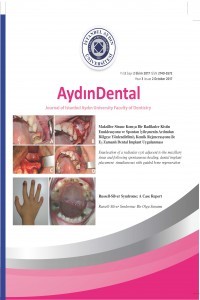Diş Beyazlatma Ürünlerinin Dentin Mikrosertliğine Etkileri
Dentin mikro sertleşmeler, intrakoronal beyazlatma, beyazlatıcı ürün
Effect of Tooth Whitening (Bleaching) Agent on Dentin Microhardness
dentin micro hardness, intracoronal bleaching, whitening agent,
___
- Hasson H,Ismail AI,Neıva G.Home -based chemically induced whitening of teeth in adults The Cochrane Collaboration 2007.
- Goldstein RE,Garber DA.Complete Dental Bleaching Quintessence Pub Co,Chicago,1995.
- Rotstein I,Friedman S.pH variation among materials used for ıntracoronal bleaching.J Endod 17,376,1991.
- Costas FL,Wong M,Intracoronal ısolatin barriers:Effect of location on root leakage and effective ness of bleaching agents.J Endod 17,8,1991.
- Cherry DV, Bowers DE,Thomas Jr L,Redmond AF.Acute toxicological effects of ingested tooth whitens in female rats.J Dent Res 1993,72:1298-1303
- Freccia WF,et al.An ın vıtro comparison of non vital bleaching techniques in the discolored tooth.J Endod 8,70,1982.
- Rotstein I,et al. Histochemical analysis of dental hard tissues following bleaching .J Endod 22,23,1996.
- Martin dunitz,greenwall linda.Bleaching technıques in restorative dentistry.2001.20-24
- Goldstein RE, Garber DA. Complete dental bleaching.Chıcago: quıntessence Publishing;1995.165
- Lewinstein I, Hirschfeld Z, Stabholz A, Rotstein I. Effect of hidrogen peroxide and sodium perborate on the microhardness of human enamel and dentin. J Endod 20:61-3,1994.
- Kwong K, Mohammed S, McMillan MD, Stokes AN. Evaluation of a 10 percent carbamide peroxide gel vital bleaching agent. N Z Dent J 1993;89:18-22.
- Lewinstein I, Hirschfeld Z, Stabholz A, Rotstein I. Effect of hidrogen peroxide and sodium perborate on the microhardness of human enamel and dentin. J Endod 20:61-3,1994.
- In vitro assessment of a gel base containing 2% chlorhexidine as a sodium perborate ‘s vehicle for ıntracoronal bleaching of discolored teeth. 2006,32(7),672-674.
- Lım MY et all.An in vitro comparison of bleaching efficiacy Singleton LS; Wagner MJ. Peroxide tooth whitener concentration. Versus composite resin
- etching. J Dent Res, 71: .281-286, 1992.
- ISSN: 2149-5572
- Yayın Aralığı: Yılda 3 Sayı
- Başlangıç: 2015
- Yayıncı: İstanbul Aydın Üniversitesi
Endodontic Systems Working With Reciprocal Movements For Instrumentation of Root Canals
Buket AYNA, Emrah AYNA, Sema ÇELENK, Behiye BOLGÜL, Ersin UYSAL
Eroziv Lezyonlarin Direkt Kompozit Lamina Venerler ile Minimal İnvaziv Restorasyonu: Olgu
Diş Beyazlatma Ürünlerinin Dentin Mikrosertliğine Etkileri
Yumuşak Dokunun Estetik Tedavi Planındaki Yeri
Lokalize Dişeti Çekilmesine Multidisipliner Yaklaşım: Bir Olgu Sunumu
Burcu KARADUMAN, Cenker KOYUNCUOĞLU, Sevda ATALAY, Ece ÇALIŞKAN, Nurcan TEZCİ, Sabri Hasan MERİÇ
Rezin Nano Seramik Endokron: Post-Kor Destekli Kron Restorasyonlara Bir Alternatif
İşıl Kaya BÜYÜKBAYRAM, Gülce ALP
Rubberdam Clamp Ingestion During Root Canal Treatment: A
Ece ÇALIŞKAN, Hafiz Hande GÜRBÜZ, Rüştü DAĞLAROĞLU, Raif ERİŞEN
